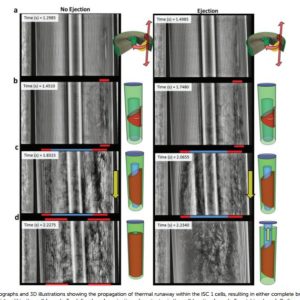Researchers from NASA, the DoE’s Renewable Lab, and the EU are getting insights into why lithium-ion cells fail thanks to the use of a device that induces short circuits inside the battery itself.
The device researchers came up with can induce an internal short circuit on-demand and at a pre-determined location inside commercially available spiral-wound Li-ion batteries. The temperature-activated device mimics hidden defects that can arise during the battery manufacturing processes.
The team used the device, dubbed an internal short circuit (ISC) device, to gain insight into cell design vulnerabilities by causing cell walls to rupture or cells to burst open. To watch what happened, they imaged the events via high-speed X-ray imaging at the European Synchrotron Radiation Facility. There they could observe what unfolded in the cells in real-time, as the short circuit caused the catastrophic failure process to propagate.

Individual cells, as well as small cell modules, were tested under conditions that represented a worst-case battery failure scenario. Short circuits were initiated inside the batteries at ~60⁰C. During the failure process, cell temperatures reached in excess of 1,085⁰C. This must have been something to see: Researchers report that batteries exploded on an hourly basis.
The EU synchrotron facility was able to provide high flux X-rays to follow the quick unfolding of events with both high spatial and temporal resolution. Researchers imaged the batteries at up to 2,000 frames/sec. The cells under investigation measured 18 mm in diameter and 65 mm high, but the imaging field of view was in the tens of millimeters deep, enabling the imaging of more than one cell at a time. This helped investigate how failure could propagate from one cell to another, leading to large-scale failure in a battery pack.
Among other things, researchers found that thermal runaway propagates faster in the longitudinal and azimuthal directions, rather than the radial direction, by more than an order of magnitude. Cylindrically shaped fluidized reaction zones developed that essentially resulted in an intact core being encompassed by a fluidized region, reducing the shear stress on the intact electrode assembly and contributing to it shifting towards and clogging the vent. This increased the risk of pressure build-up and cell bursting. So an alternative path for pressure release would help avoid the build-up of pressure when the vent is clogged, researchers say.
Researchers also say sidewall rupture presents one of the greatest hazards during thermal runaway, and was shown to be more likely when thermal runaway initiates closer to the casing of the cell. The cylindrical mandrel in the core of the electrode assembly was also shown to influence the venting process. The mandrel maintains an opening for gasses to escape but may also damage the vent and safety devices at the cap of the cell when propelled during thermal runaway.
Researchers described their work in the journal Energy & Environmental Science.


Could the separator be made so that when it got hot, it would release a small amount of acid/alkali/solvent that would quickly dissolve the offending dendrite ?